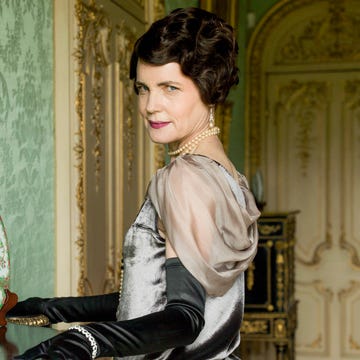My bathroom looks like a crime scene. There are crimson red splashes on the wall, the sink, the floor, the window, the tiles and even the loo seat. And once I get my hands on the teenager responsible, don’t blame me if there’s an actual murder committed…
Now before anyone calls social services, this is a tale about my daughter dyeing, not dying! But I know for sure that her school is – quite rightly – going to view her makeover as one of its deadly sins, going completely against its uniform policy. Having a blatantly artificial hair colour is a red line, and oh boy, is this red.
A quick rummage in the bin confirms the worst: an empty packet of super-strong permanent dye in bright crimson. The culprit herself is skulking in her bedroom, about to be caught literally red-handed. (Apparently the protective gloves ‘broke’ midway through.)
What to read next
Her hair, being gloriously healthy and hitherto unprocessed, has happily slurped up every molecule of dye, going from mid-brown to magenta. If she was at college it would be funky, but that’s beside the point: it’s against the rules. Sure enough, there’s a phone call from the school the next day, politely but firmly explaining that she’s excluded from lessons until it’s fixed. Too right.
The Teen returns home late, having tried and failed to smother it with a brunette box dye at a friend’s house. (I pray for their bathroom.) Her failure is predictable. As many colourists have explained to me, permanent dye cannot lift permanent dye. It’s like a game of musical chairs: the red got in there first and is now hogging all the hair cuticle space, thumbing its nose at would-be interlopers.
I’m no stranger to box dye, having had many years of covering my own grey roots at home, but this situation is way beyond my skill set. The solution apparently suggested by school to The Teen – ‘just dye it black’ – fills me with horror.
Not only will a Claudia Winkleman black dye job look just as artificial as magenta, I’m not signing up to a future of colouring her roots as well as my own every month. Time to call in the professionals.
How to get rid of red dye
I hope my daughter knows how lucky she is to have a beauty director as a mother. Others might be left scrubbing away for days with bicarbonate of soda; she’s in the award-winning surroundings of an Edward James salon. The founder himself is on the salon floor today, and is generously taking time out from his usual schedule of elite hairdressing to cast his expert eye over this reprobate.
My only criticism is that Edward is far too lovely to give her the ticking off she deserves. ‘It’s a rite of passage,’ he says. ‘It’s bringing back memories of my own school days, being dragged in by the head of year for having coloured hair and trying to pretend it was natural.’ (Hmm, maybe my daughter should consider a career in hairdressing?)
She’s certainly not the first teen he’s seen with a foolish DIY makeover and she won’t be the last. ‘We’re constantly seeing teenagers who’ve “had a go” at home colour — sometimes with box dye, sometimes with questionable TikTok tips — and then land in hot water with their school,’ Edward tells me. ‘The important thing is to get proper advice from a professional, rather than trying to fix it yourself.’
Because yes, while the Reddit threads advice (bicarb, Fairy Liquid, clarifying shampoos et al) will fade red dye a smidge, ‘it’s not going to be a pretty fade,’ he explains. ‘For a permanent red dye to have such a vibrant effect, it has to really lift the natural hair first. As the red fades, you’re going to start seeing the lifted shade underneath.’
And spoiler alert: it’s not a chic, Gwyneth Paltrow gold. ‘It’s going to be an orangey-ginger,’ he says. So be warned, even when you see a pro, you’d better expect your hair to look (temporarily) worse before it looks better.
What if it’s semi-permanent dye?
The one exception to this advice is if the regrettable ‘makeover’ has come from a non-permanent colour, typically designed to last around 20 washes. ‘Semi-permanent dye doesn’t penetrate the hair shaft like permanent dye, it just stains the outside,’ explains Edward. ‘This means it can be faded out at home more easily.’
To do this, ‘wash the hair more frequently than usual, ideally with a clarifying or anti-dandruff shampoo, and follow with a deep conditioner each time,’ says Edward. ‘You can also add a small amount of baking soda to the shampoo in a one-off treatment, but don’t overdo it. Be patient and it will gradually lift.’
So if that’s what you’re dealing with, count your blessings. And if not, call the salon.
What’s involved in professional colour fixing?
First things first, it can’t be rushed. A 48-hour patch test is a non-negotiable, even if you’ve just dolloped on a box dye with zero ill effects. Once that’s out of the way, a professional will assess the hair’s colour and condition, then work out a plan.
For The Teen, it’s going to be the standard approach of a bleach bath at the backwash, followed by a corrective colour. ‘Until we’ve actually lifted the red, we won’t know what colour we’re left with. Even then, it’s impossible to know exactly what the final shade placed on top will look like,’ says Edward. ‘When you need to strip out any permanent colour, and especially a bright red, it makes the final result less predictable.’
‘However, a good colourist will be able to get as close as possible to the desired shade,’ he adds, reassuringly. For The Teen, the goal is to protect the condition and get a brown shade that won’t leave a dreadful tide mark.
‘You’ll still get some degree of regrowth line but it won’t be anything like dyeing it black,’ says Edward. ‘I definitely wouldn’t recommend that. Although black dye will cover up a bright red, it’s probably going to look harsh. The root regrowth will also look very obvious, and stripping out a dark dye will be a very difficult job for any hairdresser.’
What happened at the backwash?
When the fashion hair brand (which I won’t name) called its dye strong, it wasn’t kidding. ‘Wow, this really isn’t wanting to shift,’ says Edward, who gets the party started before handing over to his equally patient colleague, Vicky. The water turns a greasy salmon pink, rather than the flood of red I’d hoped for.
Half an hour, and much lathering later, we’re left with a truly dreadful bright tangerine barnet, interspersed with banana-yellow under-sections which The Teen obviously hadn’t dyed quite as thoroughly.
I can truthfully say that my daughter now has the hair of a movie star. Unfortunately, it’s Milla Jovovich in The Fifth Element.
How is this stage fixed?
Two words: don’t panic! This interim phase is awful, but entirely expected. ‘What we’re going to do now is use a cool-toned brown shade to colour the hair and also knock down those warm tones,’ says Vicky.
Won’t this totally trash her hair? ‘No, because we’re applying a permanent colour that simply deposits pigment into the hair shaft — it’s not lightening or breaking anything down,’ reassures Vicky. She switches to a demi-permanent dye for the lengths and ends ‘to neutralise any remaining brassiness, without the risk of the hair going too dark.’
Once this new batch of dye has had time to develop, it’s back off to the backwash to rinse, reassess and tweak the final colour with toner. ‘Toner is what makes all the difference to the finished result of a colour correction, and it’s where professional expertise really comes into play,’ says Vicky.
Even as a seasoned pro, she finds The Teen’s hair a challenge. ‘I’ve had to use four different toners, with green and blue tones, to balance the warmth,’ she says, looking triumphant but slightly exhausted as she returns from the backwash.
How did it turn out?
What a miraculous save. The Teen’s hair has been left a rich yet natural-looking brunette, which even the nit-pickiest of teachers couldn’t object to. It’s more than she deserves, but she’s dodged the bullet of shredded condition, with hair that’s still far shinier and softer than mine.
‘Permanent dye and lightening will have changed the structure, but that doesn’t mean that it’s now in bad condition,’ says Edward, coming over to assess the result.
As with any colour-corrected hair, though, The Teen’s will now require more care. ‘When you’ve taken out red dye, the new, cooler colour applied over the top will fade over time, and you’ll start seeing those warmer tones coming through,’ explains Edward. ‘Most clients will need to come back for another correcting toner in around four weeks.’
In the meantime, Edward advises using purple shampoo once a week. ‘Using it more often can dull the colour or give a temporary purple-ish hue, so once weekly is a good guide.’
‘I'd also advise using a treatment that supports the internal hair structure,’ he adds. ‘Aveda’s Botanical Repair range is brilliant – it improves the feel of the hair and also helps to repair the bonds. A hydrating mask once a week and a leave-in conditioner after every wash will really help protect the hair’s integrity.’
Speaking of which, The Teen’s blasé use of irons, minus any kind of heat shield, now needs to come to an abrupt end. ‘It’s very, very important to use heat protection every single time you use hot tools, as they really speed up colour fade otherwise,’ he warns.
Lesson learned and heeded, I’d like to think. The Teen heads back to school with a swish, having promised Edward she’ll treat her hair with a lot more respect and thought in future.
Let’s hope my bathroom gets the same level of consideration. Otherwise, I really will be seeing red!
*Edward James is the founder of four luxury London salons, in Richmond, Balham, Battersea and Putney. Colour cleansing starts from £60. Full colour correction is a bespoke treatment, starting from £150. For appointments visit edwardjameslondon.com























